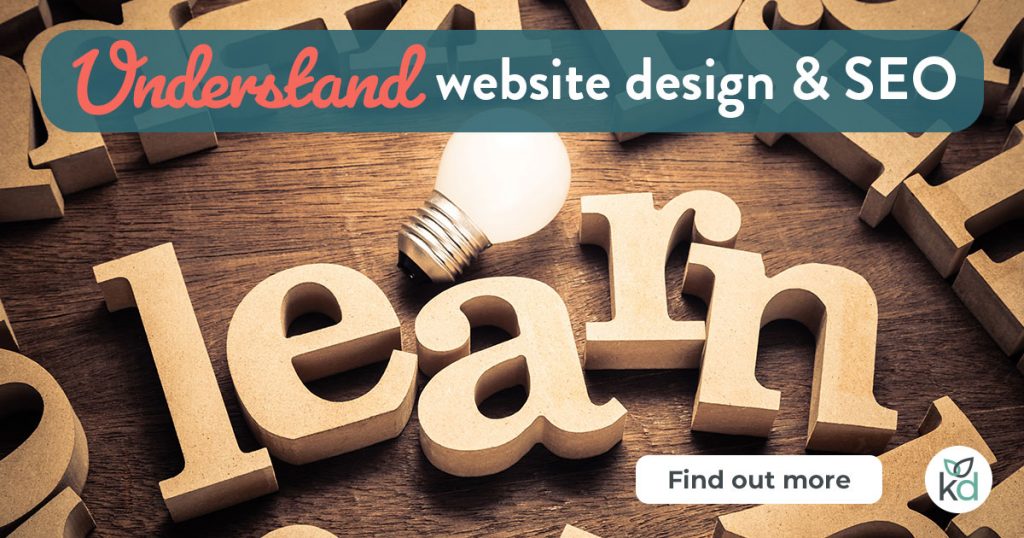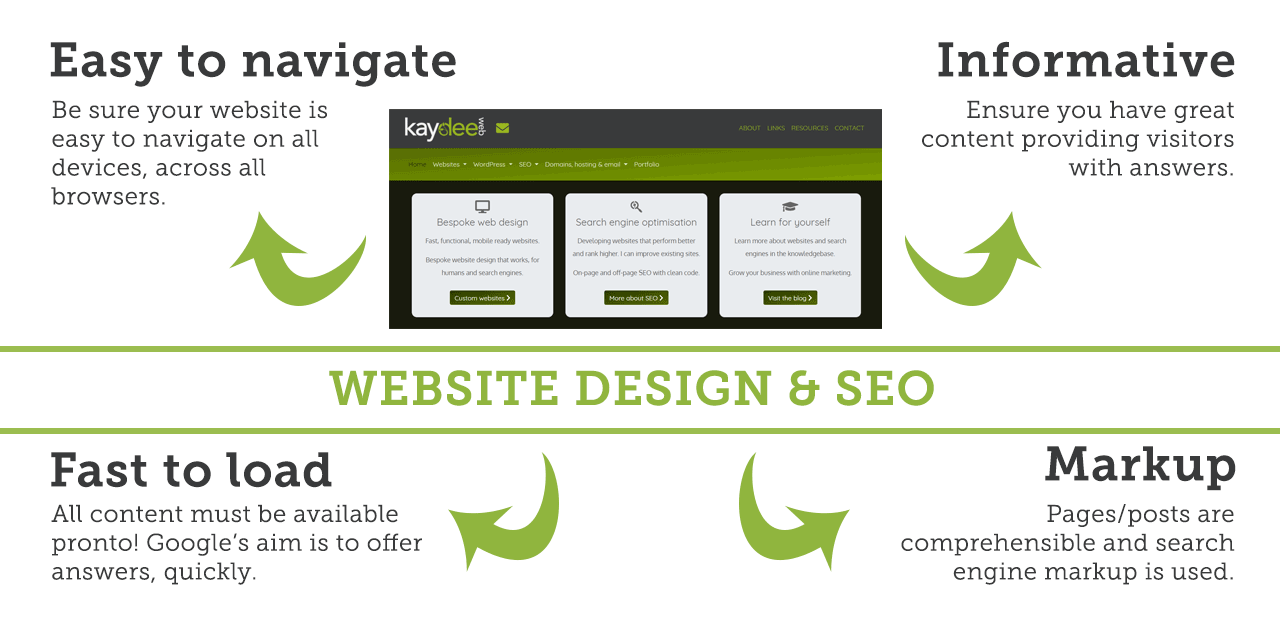When you understand the relationship between website design and SEO (search engine optimisation) you’ll recognise ways that design can be adjusted to aid search results.
Website design for performance will increase page rank and gain exposure. That leads to more traffic to the website and generate sales.
Learn how improper website design has a negative effect on search results.
Monitor, improve and nurture your website instead of leaving it to float in the ether.

What is SEO?
There are two main branches to search engine optimisation. On-page and off-page.
On-page search engine optimisation is when a website owner ensures pages, posts, content, media and links are easily navigable, download fast, are formed well and clearly labelled.
There are standardised guidelines for web designers and website owners to follow that help search engines to understand websites. Many of these guidelines help the user too.
The objective of the search engine is the objective of the user.
Off-page optimisation refers to backlinks, reviews and can also involve social media.
For the most part of this post, I refer to on-page SEO, which can easily help a website to rank better.
How are website design and SEO linked?
A search engine, like Google, aspires to offer the best experience and the most relevant search result to its users.
If Google does not provide that information, they have failed in their responsibilities.
Google rewards websites that are organised and up to date, by placing website listings at a higher rank on search engine result pages (SERPs).
This happens when:
- The website is easy to navigate on all devices.
- The pages/posts are comprehensible and search engine markup is used.
- There is great content providing visitors with answers.
- All content is available pronto! Google’s aim is to offer answers, quickly.
The better your content, the better each page ranks on Google for targeted key terms. Strong pages do even better once your whole website has been optimised.
The better the page ranks the more visibility so traffic is bound to increase. As Google sees more click-throughs the website climbs rank.
However, a page with great content and the best keywords will never be truly successful if the site itself is slow to load or it is difficult to find information.
So you see, there is more to successful website design than a visual brochure.

Search engine optimisation for Google
Google infrequently announces what they expect from websites. Algorithms often change to prevent manipulative practices. That is why SEO is complicated and takes time.
Looking at Google’s guidelines they make perfect sense. Give customers a good experience on a website and Google will rank it well.
Here are some basic principles.
Basic Google principles
Make your website easy to navigate. Use a clear page hierarchy for both Google crawlers and users. Links to pages that do not exist have an adverse effect on rank so weed them out.
Load websites quickly
Large images and too much code increase web page download time. Be sure that pages load quickly. If using a CMS system delete unused plugins, images and code that are not used. Keep pages clean. Consider slower connections like 4G, especially if the business is found ‘on the go’, as a tourist attraction. Balance great design with a fast load time.
Design websites for all devices and all browsers
A website must load well and be easy to use on all devices – mobile, tablet and desktop. Consider how people use the site. Google Analytics provides detailed information about users’ devices and browsers.
Create an information rich website
Google loves quality content that is informative. Everything you write should be first and foremost to help your customer. Ensure that pages offer the best, most relevant content around a chosen key term and you will not go far wrong. Use a blog to continuously expand that content.
Create for customers, not search engines
Never deceive visitors by bringing them to a page using unrelated key terms. Always ask yourself if you are helping your visitors.
Do not hide information
Content hidden behind tabs or expandable boxes is considered by Google to be less accessible to users. Be sure the most important information is available when the user arrives. Do not make them wait or dig.
Use images
Popular images are displayed as an image pack on Google search pages not to mention Google’s specific image searches. Images expand exposure and traffic. The more traffic, the better the page rank. When putting a site together give Google as much information about the image as possible using the image file name and ALT tag. Let people filch your images, requiring them to link to your site to increase backlinks.
Use videos
Relevant video content from YouTube is listed as a feature at the top of the first page of Google search. A prominent position for your video so include informative videos on your blog posts and pages.
Visually impaired users
Visually impaired users browse the web with screen readers – browsers that use speech synthesizers or braille to relay what is on screen. For this reason, links and images must be appropriately labelled to help users navigate easily.
Ensure every page on your website is linked
Google will find a homepage but doesn’t crawl deep pages unless they are clearly linked. Each link should use descriptive text so visitors and search engines understand where they go. ALT tags must be used on image links.
Limit the number of links
Relevant page links help search engine crawlers and will help page authority, but do not go overboard. Too many links and no content can be seen as SPAM, crushing Google page rank.
Use targeted keywords
Targeted long-tail key terms with low competition must be used throughout the website. The titles and descriptions of your page are displayed on Google Search Result Pages. Use related key terms, writing in-depth about a topic. Research key terms using MOZ, SEM Rush or Google AdWords.
Rescue your website
Often, there is more to website design and SEO than business owners recognise.
You can save both time and money by starting out with an optimised site. Undoing bad work takes more time and effort.
If you have an existing website that is not performing well it can normally be rescued. I can take a look at the setup of your site and offer valuable advice. Just email me to ask.
Take the time yourself to re-evaluate your own website and do this habitually. Analyse the site frequently to discover areas in which it can be improved with tools such as MOZ Pro, which I can offer on a monthly basis. Results are sent by email.
Visit my web page on website optimisation for more information on SEO.
Or download MY PDF GUIDE TO A SUCCESSFUL WEBSITE, here.
